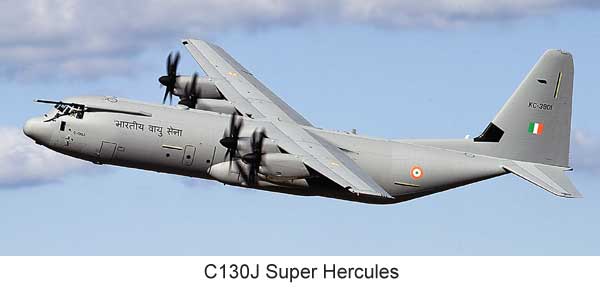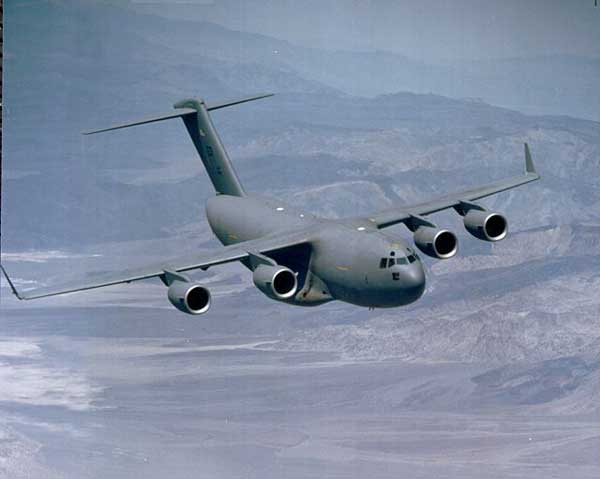New Acquisitions from the US
The first to be inducted were the three Boeing Business Jets (BBJ) for Air Headquarters Communication Squadron dedicated to VVIP travel. Acquired through the Foreign Military Sales (FMS) programme of the US government and not through the open tender system, the BBJs replace the three ageing Boeing 737 aircraft acquired earlier on from the Indian civil aviation sector. The BBJs augment the four Embraer 135 Legacy Business Jets from the Brazilian manufacturer already in service with the Squadron.
 The next big ticket purchase has been the six four-engine turboprop C130J Super Hercules aircraft for Special Operations procured from US aerospace major Lockheed Martin through the FMS route in a deal worth $1 billion (` 5,000 crore). The relatively small fleet is already operational with the IAF having taken part in disaster relief operations in Sikkim after the recent devastating earthquake. It is understood that six additional C130J aircraft are to be ordered soon to bring the fleet to full squadron strength. With a maximum payload capacity of over 21 tonnes, the Super Hercules bridges the gap between the five-tonne payload capacity AN32 and the 43-tonne capacity IL76. Apart from its capability to carry 128 fully equipped soldiers or 92 paratroops, the aircraft is capable of both strategic and tactical roles. It has good hot and high performance and can operate from semi-prepared and short dirt strips.
The next big ticket purchase has been the six four-engine turboprop C130J Super Hercules aircraft for Special Operations procured from US aerospace major Lockheed Martin through the FMS route in a deal worth $1 billion (` 5,000 crore). The relatively small fleet is already operational with the IAF having taken part in disaster relief operations in Sikkim after the recent devastating earthquake. It is understood that six additional C130J aircraft are to be ordered soon to bring the fleet to full squadron strength. With a maximum payload capacity of over 21 tonnes, the Super Hercules bridges the gap between the five-tonne payload capacity AN32 and the 43-tonne capacity IL76. Apart from its capability to carry 128 fully equipped soldiers or 92 paratroops, the aircraft is capable of both strategic and tactical roles. It has good hot and high performance and can operate from semi-prepared and short dirt strips.
Although the C130 has been in service since the mid fifties, the C130J Super Hercules is the latest version endowed with cutting edge technologies including the latest and the most advanced avionics such as Forward Looking Infra-Red (FLIR) and Head-Up Display (HUD). The four Rolls Royce AE 2100D3 engines provide higher levels of performance at relatively lower operating and ownership costs. While the fleet will be capable of all conventional roles associated with military transport aircraft, the primary role for the C130J Squadron will be Special Operations for which there was no dedicated fleet with the IAF so far. The aircraft has been specially modified with the equipment necessary for this exclusive role.
India – Ally or Strategic Partner?
Unfortunately, the somewhat stringent legal requirements of the US government associated with sale of military equipment normally applicable to allies, have proved to be a major irritant in the two transactions with the US government. Certain sensitive and critical equipment has been denied to India on account of refusal by the Indian government to acquiesce and sign the Communications Interoperability and Security Memorandum of Agreement (CISMOA). Insistence by the US government in respect of the CISMOA reflects the fact that it would treat India not as a “strategic partner” but an “ally” in respect of sale of defence hardware. In this respect, it appears that India is being equated with Pakistan, a traditional ally of the US. Such an approach would not be palatable either to the IAF or the Indian government.
The C17 Globemaster III
The strategic airlift capability of the IAF will be enhanced significantly with the induction of the ten C17 Globemaster III aircraft from Boeing Defence, Space & Security contracted once again through the FMS route. The C17 Globemaster III is perhaps the most advanced strategic heavy lift aircraft in the world today. Delivery of the ten aircraft in the $4.1 billion (` 20,000 crore) deal is scheduled to commence in June 2013 and is expected to be completed by 2014. It is understood that the deal includes Performance Based Logistic Support, an arrangement in which the OEM will have the responsibility to provide total maintenance and spares support at operating locations in India and abroad.
 Based on the experience of the IAF, another six aircraft may be indented taking the total to 16 by 2015. The four-engine C17, which can lift 75 tonnes, will replace the ageing fleet of IL76 aircraft in service for over two and a half decades and would be due for retirement within the next decade. At present, the IL76 fleet of the IAF is plagued with maintenance difficulties to some extent due to unsatisfactory product support from the OEM. Of the total of 17 acquired, only a few remain airworthy today. With its phenomenal payload capacity, transcontinental range and the ability to operate from short semi-prepared airstrips, the fleet of C17 Globemaster III will give the IAF unprecedented strategic airlift capability. However, when inducted, this fleet with the IAF although the second largest in the world outside the US, will have to be progressively enhanced in size in conformity with India’s growing stature and commitments in the global arena.
Based on the experience of the IAF, another six aircraft may be indented taking the total to 16 by 2015. The four-engine C17, which can lift 75 tonnes, will replace the ageing fleet of IL76 aircraft in service for over two and a half decades and would be due for retirement within the next decade. At present, the IL76 fleet of the IAF is plagued with maintenance difficulties to some extent due to unsatisfactory product support from the OEM. Of the total of 17 acquired, only a few remain airworthy today. With its phenomenal payload capacity, transcontinental range and the ability to operate from short semi-prepared airstrips, the fleet of C17 Globemaster III will give the IAF unprecedented strategic airlift capability. However, when inducted, this fleet with the IAF although the second largest in the world outside the US, will have to be progressively enhanced in size in conformity with India’s growing stature and commitments in the global arena.
Indo-Russian MTA Project
The fleet of 100 odd AN32 aircraft with the IAF is currently undergoing mid-life upgrade after which it would be available for another ten to 15 years albeit in progressively dwindling strength. With the intent to have a replacement available in good time, the HAL entered into a joint venture with United Aircraft Corporation (UAC) and Rosoboronexport of Russia to co-develop,
co-produce a 15 to 20 tonne payload capacity twin-engine military transport aircraft designated as the Multi-role Transport Aircraft (MTA). This aircraft will meet with the requirements of both the IAF and the Russian Air Force. Indications are that the IAF plans to induct 45 of these machines.
Given its payload capability, like the C130J, the MTA would be capable of both tactical and strategic roles. However, with three to four times the payload capability of the AN32, the MTA is bordering the strategic and hence cannot truly be regarded as a qualitative replacement of the former. Strangely enough, the deal appears to have run into trouble as the proposed business model received from UAC does not seem to have any significant developmental or R&D role for HAL. Participation by HAL is apparently limited to providing its share of funding and licence manufacture. It is not surprising that the Indian government has rejected the proposed business model received from the UAC. While information on further steps in the matter is awaited, this development has undoubtedly introduced a degree of uncertainty in the project. In the event of the MTA project being abandoned, the IAF will have to opt for alternatives in the western markets. HAL would do well to expand its collaborative horizons to include Brazil and South Africa.
Closing the Gap
If and when the ongoing projects including the Indo-Russian MTA joint venture are completed and the older fleet phased out, possibly by 2025, the IAF will have a modern fleet of transport aircraft consisting of the four-engine C17 Globemaster III and the C130J Super Hercules and the twin-engine MTA, all with payload capability ranging between 15 to 75 tonnes and range that would accord the fleet strategic reach. Unless a replacement for the HS748 Avro fleet is provided in good time, there will be a marked imbalance in the capability structure of the revamped transport fleet of the IAF. Apart from long range power projection tasks, the IAF is often called upon to undertake miscellaneous commitments related to its primary operational role of airborne assault operations such as resupply missions requiring landing and take-off from small airstrips, air dropping of supplies to isolated bodies of troops or in small size dropping zones, decoy missions, air maintenance in the North Eastern parts of the country and movement of security forces within the country.
Search for the replacement for the Avro fleet ought to therefore target an aircraft type in the five to ten tonne category. Absence of aircraft with such capability will compel the IAF to deploy strategic airlift aircraft for minor tactical tasks resulting in wasteful use of assets militating against the fundamental tenet of economy in the employment of resources. Possible options in this category are the Airbus Military’s CASA 235 and the C295 or the Alenia C27J Spartan from Italy. All three aircraft types have proven operational track record. It is up to the indigenous aerospace industry in the private sector to explore and evaluate options for collaboration and come up with a viable proposition to provide a replacement for the Avro fleet.





When it is clear that indigenous production is not viable, for what and why is the future action fragmented? How long does it require…….